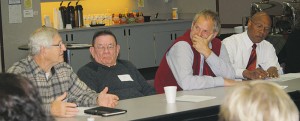Just before Sen. Jon Tester (D-Montana) took up the gavel of the Senate Committee on Indian Affairs in February, he introduced the Native Language Immersion Student Achievement Act, which would amend the Elementary and Secondary Education Act (ESEA) to provide increased federal financial support to Native American language programs at American Indian-focused schools.
RELATED: Tester, in Line to Be SCIA Chair, to Introduce Indian School Language Bill
If passed, the bill would establish a grant program to support schools using Native American languages as their primary language of instruction. The legislation would appropriate $5 million for fiscal year 2015, and “such sums as may be necessary for each of the succeeding 4 fiscal years.” The secretary of the Department of Education would be responsible for making grant awards to eligible institutions each of the years, and grantees would be required to submit annual reports.
“We are racing against the clock to save and revitalize our sacred Native American languages,” Tester said when he announced the bill. “Preserving Native languages will strengthen Indian culture and increase student confidence—leading to greater academic achievement and a stronger economy.”
Support from the National Congress of American Indians and many Native-focused organizations, which plan to hold a congressional briefing March 12 on Capitol Hill to heighten awareness of the bill, has been widespread.
“In introducing the Native Language Immersion Student Achievement Act, Sen. Tester has answered the call from Indian country to invest in Native language immersion schools,” says Brian Cladoosby, president of the National Congress of American Indians. “Not only are these unique schools our best hope to save and revitalize our sacred Native languages, but they offer Indian education the purest form of intellectual sovereignty, because no right is more sacred to Native peoples than the right to freely speak our Native languages.”
Native education advocates widely view the bill as an opportunity to influence ESEA reauthorization discussions that are ongoing in the Senate. While the ESEA, which includes the Indian Education Act, still faces some hurdles in passing this Congress, advocates are hopeful that Tester’s legislation can ultimately be included in that broader education legislation.
“Sen. Tester’s bill offers Indian country heightened ownership in its educational destiny and a lifeline in saving Native Languages,” says Ryan Wilson, president of the National Alliance to Save Native Languages, which is hosting the Capitol Hill briefing. “Just as important to Indian country it is good policy and reflects a sharpened focus and stronger Indian Education Act.”
Wilson says that tribal recommendations to enhance the Native language and education components of the ESEA have gone unheeded by the Senate Committee on Health, Education, Labor, & Pensions (HELP) to date.
“Senate Committee on Indian Affairs recommendations from the 112th Congress that were contained in the groundbreaking Native Class Act and Native Build Act were not reflected as well,” Wilson adds. “Native language provisions published within the White House ESEA blueprint were also not included.”
Wilson says the Alliance is calling on Sen. Tom Harkin (D-Iowa), chairman of the HELP committee, to include provisions contained within the Native Language Immersion Student Achievement Act when the committee ultimately moves its ESEA bill to the Senate floor.
As this policy discussion unfolds, tribal advocates are also noting ideas that they believe could strengthen Tester’s bill.
John Echohawk, executive director of the Native American Rights Fund (NARF), which provides legal counsel to the Tribal Education Department National Assembly, is taking the opportunity to advocate for a strong role for tribal governments in saving Native languages as part of this legislation.
“Many tribes now have Tribal Education Departments or Agencies (TEAs),” Echohawk says. “Under tribal law, under the laws of some states, and increasingly even under federal law, TEAs are in the best position to coordinate resources from tribal, federal, and state programs to focus on language immersion programs in schools and communities. Some TEAs are even developing and implementing the needed language preservation and immersion programs.
“As they grow in numbers and capacity, TEAs are consistently taking the lead in meeting the need for tribal language, culture, and history programs and curricula,” Echohawk says. “TEAs are very familiar with the link—as recognized in scores of federal reports—between culturally relevant schooling, including language immersion programs, and Native student success.”
Echohawk is scheduled to appear at the March 12 Capitol Hill briefing on the legislation.
Read more at http://indiancountrytodaymedianetwork.com/2014/03/11/native-advocates-ramp-support-sen-testers-language-bill-153956?page=0%2C1








